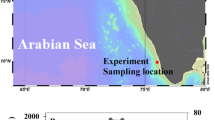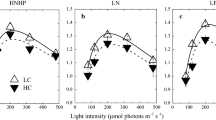Abstract
Ocean acidification (OA) and global warming-induced water column stratification can significantly alter phytoplankton-related biological activity in the marine ecosystem. Yet how these changes may play out in the tropical Indian Ocean remains unclear. This study investigated the ecological and metabolic responses of the different phytoplankton functional groups to elevated CO2 partial pressure and nitrate deficiency in two different environments of the eastern Indian Ocean (EIO). It is revealed that phytoplankton growth and metabolic rates are more sensitive to inorganic nutrients rather than CO2. The combined interactive effects of OA and N-limitation on phytoplankton populations are functional group-specific. In particular, the abundance and calcification rate of calcifying coccolithophores are expected to be enhanced in the future EIO. The underlying mechanisms for this enhancement may be ascribed to coccolithophore’s lower carbon concentrating mechanisms (CCMs) efficiency and OA-induced [HCO −3 ] increase. In comparison, the abundance of non-calcifying microphytoplankton (e.g., diatoms and dinoflagellates) and primary productivity would be inhibited under those conditions. Different from previous laboratory experiments, interspecific competition for resources would be an important consideration in the natural phytoplankton populations. These combined factors would roughly determine calcifying coccolithophores as “winners” and non-calcifying microphytoplankton as “losers” in the future ocean scenario. Due to the large species-specific differences in phytoplankton sensitivity to OA, comprehensive investigations on oceanic phytoplankton communities are essential to precisely predict phytoplankton ecophysiological response to ocean acidification.
Similar content being viewed by others
Data Availability Statement
The data used to support the findings of this study are available from the corresponding author upon request.
References
Bach L T, Alvarez-Fernandez S, Hornick T, Stuhr A, Riebesell U. 2017. Simulated ocean acidification reveals winners and losers in coastal phytoplankton. PLoS One, 12(11): e0188198, https://doi.org/10.1371/journal.pone.0188198.
Bach L T, Taucher J. 2019. CO2 effects on diatoms: a synthesis of more than a decade of ocean acidification experiments with natural communities. Ocean Science, 15(4): 1159–1175, https://doi.org/10.5194/os-15-1159-2019.
Balch W M, Drapeau D T, Fritz J J. 2000. Monsoonal forcing of calcification in the Arabian Sea. Deep Sea Research Part II: Topical Studies in Oceanography, 47(7–8): 1301–1337, https://doi.org/10.1016/S0967-0645(99)00145-9.
Bellerby R G J. 2017. Oceanography: ocean acidification without borders. Nature Climate Change, 7(4): 241–242, https://doi.org/10.1038/nclimate3247.
Boyd P W, Lennartz S T, Glover D M, Doney S C. 2015. Biological ramifications of climate-change-mediated oceanic multi-stressors. Nature Climate Change, 5(1): 71–79, https://doi.org/10.1038/nclimate2441.
Chen G X, Han W Q, Li Y L, Wang D X. 2016a. Interannual variability of equatorial eastern Indian Ocean upwelling: local versus remote forcing. Journal of Physical Oceanography, 46(3): 789–807, https://doi.org/10.1175/jpo-d-15-0117.1.
Chen G X, Han W Q, Shu Y Q, Li Y L, Wang D X, Xie Q. 2016b. The role of Equatorial Undercurrent in sustaining the Eastern Indian Ocean upwelling. Geophysical Research Letters, 43(12): 6444–6451, https://doi.org/10.1002/2016GL069433.
Chen G X, Li Y L, Xie Q, Wang D X. 2018. Origins of eddy kinetic energy in the Bay of Bengal. Journal of Geophysical Research: Oceans, 123(3): 2097–2115, https://doi.org/10.1002/2017JC013455.
Davey M, Tarran G A, Mills M M, Ridame C, Geider R J, LaRoche J. 2008. Nutrient limitation ofpicophytoplankton photosynthesis and growth in the tropical North Atlantic. Limnology and Oceanography, 53(5): 1722–1733, https://doi.org/10.4319/lo.2008.53.5.1722.
Doney S C, Fabry V J, Feely R A, Kleypas J A. 2009. Ocean acidification: the other CO2 problem. Annual Review of Marine Science, 1: 169–192, https://doi.org/10.1146/annurev.marine.010908.163834.
Duarte C M, Hendriks I E, Moore T S, Olsen Y S, Steckbauer A, Ramajo L, Carstensen J, Trotter J A, McCulloch M. 2013. Is ocean acidification an open-ocean syndrome? Understanding anthropogenic impacts on seawater pH. Estuaries and Coasts, 36(2): 221–236.
Fu F X, Tatters A O, Hutchins D A. 2012. Global change and the future of harmful algal blooms in the ocean. Marine Ecology Progress Series, 470: 207–233, https://doi.org/10.3354/meps10047.
Fu F X, Warner M E, Zhang Y H, Feng Y Y, Hutchins D A. 2007. Effects of increased temperature and CO2 on photosynthesis, growth, and elemental ratios in marine Synechococcus and Prochlorococcus (Cyanobacteria). Journal of Phycology, 43(3): 485–496, https://doi.org/10.1111/j.1529-8817.2007.00355.x.
Guillard R R L, Ryther J H. 1962. Studies of marine planktonic diatoms: I. Cyclotella nana Hustedt, and Detonula confervacea (CLEVE) Gran. Canadian Journal of Microbiology, 8(2): 229–239.
Hama T, Kawashima S, Shimotori K, Satoh Y, Omori Y, Wada S, Adachi T, Hasegawa S, Midorikawa T, Ishii M, Saito S, Sasano D, Endo H, Nakayama T, Inouye I. 2012. Effect of ocean acidification on coastal phytoplankton composition and accompanying organic nitrogen production. Journal of Oceanography, 68(1): 183–194, https://doi.org/10.1007/s10872-011-0084-6.
Hare C E, Leblanc K, DiTullio G R, Kudela R M, Zhang Y H, Lee P A, Riseman S, Hutchins D A. 2007. Consequences of increased temperature and CO2 for phytoplankton community structure in the Bering Sea. Marine Ecology Progress Series, 352: 9–16, https://doi.org/10.3354/meps07182.
Hofmann G E, Barry J P, Edmunds P J, Gates R D, Hutchins D A, Klinger T, Sewell M A. 2010. The effect of ocean acidification on calcifying organisms in marine ecosystems: an organism-to-ecosystem perspective. Annual Review of Ecology, 41(1): 127–147, https://doi.org/10.1146/annurev.ecolsys.110308.120227.
Iglesias-Rodriguez M D, Halloran P R, Rickaby R E M, Hall I R, Colmenero-Hidalgo E, Gittins J R, Green D R H, Tyrrell T, Gibbs S J, von Dassow P, Rehm E, Armbrust E V, Boessenkool K P. 2008. Phytoplankton calcification in a high-CO2 world. Science, 320(5874): 336–340, https://doi.org/10.1126/science.1154122.
Kim J M, Lee K, Shin K, Kang J H, Lee H W, Kim M, Jang P G, Jang M C. 2006. The effect of seawater CO2 concentration on growth of a natural phytoplankton assemblage in a controlled mesocosm experiment. Limnology and Oceanography, 51(4): 1629–1636, https://doi.org/10.4319/lo.2006.51.4.1629.
Kleypas J A, Feely R A, Fabry V J, Langdon C, Sabine C L, Robbins L L. 2006. Impacts of Ocean Acidification on Coral Reefs and Other Marine Calcifiers: A Guide for Future Research. NSF, NOAA, USGS, Arlington, Washington, Reston.
Krumhardt K M, Lovenduski N S, Long M C, Levy M, Lindsay K, Moore J K, Nissen C. 2019. Coccolithophore growth and calcification in an acidified ocean: insights from Community Earth System Model simulations. Journal of Advances in Modeling Earth Systems, 11(5): 1418–1437, https://doi.org/10.1029/2018MS001483.
Li C L. 2019. A Comparative Study of Seasonal Acidification in Southern Nearshore and Central Offshore Waters of the North Yellow Sea. Shandong University, Ji’nan. (in Chinese with English abstract)
Liu H J, Sun J, Wang D X, Zhang X D, Zhang C X, Song S Q, Thangaraj S. 2018. Distribution of living coccolithophores in eastern Indian Ocean during spring intermonsoon. Scientific Reports, 8(1): 12488, https://doi.org/10.1038/s41598-018-29688-w.
Luo J J, Sasaki W, Masumoto Y. 2012. Indian Ocean warming modulates Pacific climate change. Proceedings of the National Academy of Sciences of the United States of America, 109(46): 18701–18706.
Marinov I, Doney S C, Lima I D. 2010. Response of ocean phytoplankton community structure to climate change over the 21st century: partitioning the effects of nutrients, temperature and light. Biogeosciences, 7(12): 3941–3959, https://doi.org/10.5194/bg-7-3941-2010.
Meyer J, Riebesell U. 2015. Reviews and syntheses: responses of coccolithophores to ocean acidification: a metaanalysis. Biogeosciences, 12(6): 1671–1682, https://doi.org/10.5194/bg-12-1671-2015.
Mochizuki T, Kimoto M, Watanabe M, Chikamoto Y, Ishii M. 2016. Interbasin effects of the Indian Ocean on Pacific decadal climate change. Geophysical Research Letters, 43(13): 7168–7175.
Paasche E, Brubak S. 1994. Enhanced calcification in the coccolithophorid Emiliania huxleyi (Haptophyceae) under phosphorus limitation. Phycologia, 33(5): 324–330, https://doi.org/10.2216/i0031-8884-33-5-324.1.
Qi D, Chen L Q, Chen B S, Gao Z Y, Zhong W L, Feely R, Anderson L, Sun H, Chen J F, Chen M, Zhan L Y, Zhang Y H, Cai W J. 2017. Increase in acidifying water in the western Arctic Ocean. Nature Climate Change, 7(3): 195–199, https://doi.org/10.1038/nclimate3228.
Ridgwell A, Schmidt D N, Turley C, Brownlee C, Maldonado M T, Tortell P, Young J R. 2009. From laboratory manipulations to Earth system models: scaling calcification impacts of ocean acidification. Biogeosciences, 6(11): 2611–2623.
Riebesell U, Gattuso J P. 2015. Lessons learned from ocean acidification research. Nature Climate Change, 5(1): 12–14.
Riebesell U, Schulz K G, Bellerby R G J, Botros M, Fritsche P, Meyerhöfer M, Neill C, Nondal G, Oschlies A, Wohlers J, Zöllner E. 2007. Enhanced biological carbon consumption in a high CO2 ocean. Nature, 450(7169): 545–548, https://doi.org/10.1038/nature06267.
Roleda M Y, Cornwall C E, Feng Y Y, McGraw C M, Smith A M, Hurd C L. 2015. Effect of ocean acidification and pH fluctuations on the growth and development of coralline algal recruits, and an associated benthic algal assemblage. PLoS One, 10(10): e0140394, https://doi.org/10.1371/journal.pone.0140394.
Sarmiento J L, Slater R, Barber R, Bopp L, Doney S C, Hirst A C, Kleypas J, Matear R, Mikolajewicz U, Monfray P, Soldatov V, Spall S A, Stouffer R. 2004. Response of ocean ecosystems to climate warming. Global Biogeochemical Cycles, 18(3): GB3003.
Shi D, Xu Y, Morel F M M. 2009. Effects of the pH/pCO2 control method on medium chemistry and phytoplankton growth. Biogeosciences, 6(7): 1199–1207.
Smith H E K, Tyrrell T, Charalampopoulou A, Dumousseaud C, Legge O J, Birchenough S, Pettit L R, Garley R, Hartman S E, Hartman M C, Sagoo N, Daniels C J, Achterberg E P, Hydes D J. 2012. Predominance of heavily calcified coccolithophores at low CaCO3 saturation during winter in the Bay of Biscay. Proceedings of the National Academy of Sciences of the United States of America, 109(23): 8845–8849, https://doi.org/10.1073/pnas.1117508109.
Strutton P G, Coles V J, Hood R R, Matear R J, McPhaden M J, Phillips H E. 2015. Biogeochemical variability in the central equatorial Indian Ocean during the monsoon transition. Biogeosciences, 12(8): 2367–2382, https://doi.org/10.5194/bg-12-2367-2015.
Sun J, Liu D Y, Qian S B. 2002. A quantitative research and analysis method for marine phytoplankton: an introduction to Utermöhl method and its modification. Journal of Oceanography of Huanghai & Bohai Seas, 20(2): 105–112. (in Chinese)
Tortell P D, DiTullio G R, Sigman D M, Morel F M M. 2002. CO2 effects on taxonomic composition and nutrient utilization in an Equatorial Pacific phytoplankton assemblage. Marine Ecology Progress Series, 236: 37–43, https://doi.org/10.3354/meps236037.
Tortell P D, Payne C D, Li Y Y, Trimborn S, Rost B, Smith W O, Riesselman C, Dunbar R B, Sedwick P, DiTullio G R. 2008. CO2 sensitivity of Southern Ocean phytoplankton. Geophysical Research Letters, 35(4): L04605, https://doi.org/10.1029/2007GL032583.
Walker C. 2018. Mechanisms of Calcification in Coccolithophores. University of Southampton, Southampton.
Wood H L, Spicer J I, Widdicombe S. 2008. Ocean acidification may increase calcification rates, but at a cost. Proceedings of the Royal Society B: Biological Sciences, 275(1644): 1767–1773, https://doi.org/10.1098/rspb.2008.0343.
Xu K, Fu F X, Hutchins D A. 2014. Comparative responses of two dominant Antarctic phytoplankton taxa to interactions between ocean acidification, warming, irradiance, and iron availability. Limnology and Oceanography, 59(6): 1919–1931, https://doi.org/10.4319/lo.2014.59.6.1919.
Yoshimura T, Nishioka J, Suzuki K, Hattori H, Kiyosawa H, Watanabe Y W. 2010. Impacts of elevated CO2 on organic carbon dynamics in nutrient depleted Okhotsk Sea surface waters. Journal of Experimental Marine Biology and Ecology, 395(1–2): 191–198, https://doi.org/10.1016/j.jembe.2010.09.001.
Zapata M, Rodríguez F, Garrido J L. 2000. Separation of chlorophylls and carotenoids from marine phytoplankton: a new HPLC method using a reversed phase C8 column and pyridine-containing mobile phases. Marine Ecology Progress Series, 195: 29–45, https://doi.org/10.3354/meps195029.
Acknowledgment
We thank Dr. Misun YUN (Tianjin University of Science and Technology, China) and Dr. Dhiraj Dhondiram NARALE (Adani Power, India) for comments on the manuscript. Special thanks to the Open Cruise Project in the eastern Indian Ocean of National Natural Science Foundation of China (NORC2017-10) for sharing their ship time.
Author information
Authors and Affiliations
Corresponding author
Additional information
Supported by the National Natural Science Foundation of China (Nos. 41876134, 41676112, 41276124, 41706184) and the Changjiang Scholar Program of Chinese Ministry of Education of China (No. T2014253) to Jun SUN
Rights and permissions
About this article
Cite this article
Liu, H., Zhao, Y., Wu, C. et al. The ecological response of natural phytoplankton population and related metabolic rates to future ocean acidification. J. Ocean. Limnol. 40, 999–1011 (2022). https://doi.org/10.1007/s00343-021-1136-4
Received:
Accepted:
Published:
Issue Date:
DOI: https://doi.org/10.1007/s00343-021-1136-4




